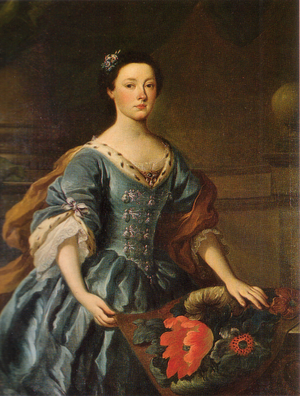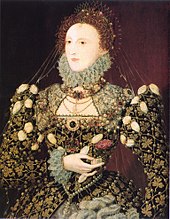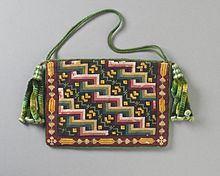English embroidery

English embroidery includes
With the
Although continental fashions in needlework were adopted in England, a number of popular styles were purely English in origin, including the embroidered linen jackets of the turn of the 17th century, stumpwork, and art needlework.[3]
Medieval period
Anglo-Saxon

Little physical evidence survives to reconstruct the early development of English embroidery before the
The documentary evidence is rather richer than the physical remains. Part of the reason for both these facts is the taste among the late Anglo-Saxon elite for embroidering using lavish amounts of precious metal thread, especially gold, which both gave items a magnificence and expense worth recording, and meant that they were well worth burning to recover the bullion. Three old vestments, almost certainly Anglo-Saxon, recycled in this way at
Scholars agree that three embroidered items from the coffin of
Scholarly consensus favours an Anglo-Saxon, probably Kentish origin for the Bayeux Tapestry. This famous narrative of the Conquest is not a true woven tapestry but an embroidered hanging worked in wool yarn on a tabby-woven linen ground using outline or stem stitch for lettering and the outlines of figures, and couching or laid work for filling in figures.[2][14][15]
Opus Anglicanum
The Anglo-Saxon embroidery style combining split stitch and couching with silk and goldwork in gold or silver-gilt thread of the Durham examples flowered from the 12th to the 14th centuries into a style known to contemporaries as Opus Anglicanum or "English work". Opus Anglicanum was made for both ecclesiastical and secular use on clothing, hangings, and other textiles. It was usually worked on linen or dark silks, or later, worked as individual motifs on linen and applied to velvet.[2][16]
Throughout this period, the designs of embroidery paralleled fashions in manuscript illumination and
Opus Anglicanum was famous throughout Europe. A "Gregory of London" was working in Rome as a gold-embroiderer to
Professional embroiderers
By the 13th century, most English goldwork was made in London workshops, which produced ecclesiastical work, clothing and furnishings for royalty and the nobility, heraldic banners and horse-trappings, and the ceremonial regalia for the great livery companies of the City of London and for the court.[17][18][19]
The founding of the embroiderer's
From the middle of the 14th century, money that had previously been spent on luxury goods like lavish embroidery was redirected to military expenditure, and imported Italian figured silks competed with native embroidery traditions. Varieties of design in textiles succeeded each other very rapidly, and they were more readily available than the more leisurely produced needlework. The work produced by the London workshops was simplified to meet the demands of this deteriorating market. The new techniques required less work and smaller quantities of expensive materials. Surface couching replaced underside couching, and allover embroidery was replaced by individual motifs worked on linen and then applied to figured silks or silk velvets.[2] Increasingly, designs for embroidery were derived directly from woven patterns, "thus losing not only their former individuality and richness, but also their former ... story-telling interest."[22]
Renaissance to Restoration

The second great flowering of English embroidery, after Opus Anglicanum, took place in the reign of
Although the majority of surviving English embroidery from the medieval period was intended for church use, this demand decreased radically with the Protestant Reformation. In contrast, the bulk of the surviving embroidery of the
Tudor and Jacobean styles
A general taste for abundant surface ornamentation is reflected in both household furnishings and in fashionable court clothing from the
Outer clothing and furnishings of woven silk brocades and velvets were ornamented with gold and silver embroidery in linear or scrolling patterns, applied bobbin lace and passementerie, and small jewels.[25][27][28]
Canvaswork in which the linen ground was covered entirely by tent, gobelin, or
Polychrome (multicoloured) silk embroidery became fashionable in the reign of Elizabeth, and from c. 1590 to 1620 a uniquely English fashion arose for embroidered linen jackets worn informally or as part of
Pattern sources

Pattern books for geometric embroidery and
The first pattern book for embroidery published in England was Moryssche & Damaschin renewed & encreased very popular for Goldsmiths & Embroiderers by Thomas Geminus (1545). Moryssche or
Additional pattern books for embroiderers appeared late in the century, followed by Richard Shorleyker's A Schole-house for the Needle published in London in 1624.[30] Other sources for embroidery designs were the popular herbals and emblem books. Both domestic and professional embroiderers probably relied on skilled draughtsmen or pattern-drawers to interpret these design sources and draw them out on linen ready to be stitched.[32]
Early samplers

Printed pattern books were not easily obtainable, and a sampler or embroidered record of stitches and patterns was the most common form of reference. 16th-century English samplers were stitched on a narrow band of fabric and totally covered with stitches. These band samplers were highly valued, often being mentioned in wills and passed down through the generations. These samplers were stitched using a variety of needlework styles, threads, and ornament.
The earliest dated surviving sampler, housed in the Victoria and Albert Museum, was made by Jane Bostocke who included her name and the date 1598 in the inscription, but the earliest documentary reference to sampler making goes back another hundred years, to the 1502 household expense accounts of Elizabeth of York, which record the purchase of an ell of linen to make a sampler for the queen.[33]
From the early 17th century, samplers became a more formal and stylized part of a girl's education, even as the motifs and patterns on the samplers faded from fashion.
Pictorial embroidery and stumpwork

Following the death of
These stories were executed in canvaswork or in coloured silks in a uniquely English style called raised work, usually known by its modern name stumpwork.[35] Raised work arose from the detached buttonhole stitch fillings and braided scrolls of late Elizabethan embroidery. Areas of the embroidery were worked on white or ivory silk grounds in a variety of stitches and prominent features were padded with horsehair or lambswool, or worked around wooden shapes or wire frames. Ribbons, spangles, beads, small pieces of lace, canvaswork slips, and other objects were added to increase the dimensionality of the finished work.[3][34]
Crewel

Sets of bed hangings embroidered in crewel wools were another characteristic product of the Stuart era. These were worked on a new fabric, a natural
After the Restoration, the patterns became ever more fanciful and exuberant. "It is an almost impossible task to describe the large leaves, since they bear no resemblance to anything natural, they are, however, rarely angular in outline, rejoicing rather in sweeping curves, and drooping points, curled over to display the under side of the leaf, a device that gave opening for much ingenuity in the arrangement of the stitches."[4]
Although usually called "Jacobean embroidery" by modern stitchers, crewel has its origins in the reign of James I but remained popular through the reign of Queen Anne and into the early 18th century, when a return to the simpler forms of the earliest work became fashionable.[4]
Glorious Revolution to the Great War
Later Stuart
The accession of
Georgian

In the Georgian era, canvaswork was popular for chair coverings, footstools, screens and card tables. Embroidered pictures and upholstery both reflected the popular pastoral theme of men and women in the sheep-cropped English countryside. Other recurring themes include exotic Tree of Life patterns influenced by earlier crewelwork and chinoiserie with its fanciful imagery of an imaginary China, asymmetry in format and whimsical contrasts of scale. In contrast, needlepainting in silks and wools produced naturalistic portraits and domestic scenes.[38][39]
Embroidery was once again an important element of
Later samplers

By the 18th century, sampler making had become an important part of girls' education in boarding and institutional schools. A commonplace component was now an
Tambourwork
Tambourwork was a new
Tambourwork was copied by machine early in the
Smocking
The linen smock-frocks worn by rural workers, especially shepherds and waggoners, in parts of England and Wales from the early eighteenth century featured fullness across the back, breast, and sleeves folded into "tubes" (narrow unpressed pleats) held in place and decorated by smocking, a type of surface embroidery in a honeycomb pattern across the pleats that controls the fullness while allowing a degree of stretch.
Embroidery styles for smock-frocks varied by region, and a number of motifs became traditional for various occupations: wheel-shapes for carters and wagoners, sheep and crooks for shepherds, and so on. Most of this embroidery was done in heavy linen thread, often in the same color as the smock.
By the mid-nineteenth century, wearing of traditional smock-frocks by country laborers was dying out, and a romantic nostalgia for England's rural past led to a fashion for women's and children's clothing loosely styled after smock-frocks. These garments are generally of very fine linen or cotton and feature delicate smocking embroidery done in cotton
Berlin work

In the early 19th century, canvaswork in tent or petit point stitch again became popular. The new fashion, using printed patterns and coloured tapestry wools imported from Berlin, was called
Art needlework

In 1848, the influential
By the 1870s, Morris's decorative arts firm Morris & Co. was offering both designs for embroideries and finished works in the art needlework style. Morris became active in the growing movement to return originality and mastery of technique to embroidery. Morris and his daughter May were early supporters of the Royal School of Art Needlework, founded in 1872, whose aim was to "restore Ornamental Needlework for secular purposes to the high place it once held among decorative arts."[47]
Textiles worked in art needlework styles were featured at the various
Modern period
Organizations whose origins date back as far as the Middle Ages remain active in supporting embroidery in Britain today.
The Worshipful Company of Broderers is now a charitable organization supporting excellence in embroidery.[49]
The
.The
Notes
- ^ Beck 1992, pp. 44–44
- ^ a b c d e f Levey and King 1993, p. 12
- ^ a b c Embroiderers' Guild 1984, p. 81
- ^ a b c d Fitwzwilliam and Hand 1912, "Introduction"
- ^ a b Embroiderers' Guild 1984, p. 54
- ^ Coatsworth, Elizabeth: "Stitches in Time: Establishing a History of Anglo-Saxon Embroidery", in Netherton and Owen-Crocker 2005, pp. 6–7
- ^ a b Levey and King 1993, p. 11
- ^ The Maaseik Embroideries, details and photos from Historical needlework resources.
- ^ Dodwell, p. 181
- ^ Dodwell, p. 182
- ^ Dodwell, pp. 129–145, 174–187, and Plate D.
- ^ Maniple and Stole of St Cuthbert details and photos from Historical needlework resources.
- ^ Coatsworth 2005, p. 16
- ^ Coatsworth 2005, pp. 22–23
- ^ Wilson 1985, pp.201–227
- ^ a b Jourdain 1912, pp. 6–8
- ^ Lemon, 2004
- ^ Jourdain 1912, pp. 13–15
- ^ a b c Levey and King 1993, p. 17
- ^ Norris p. 225
- ^ Jourdain 1912, p. 56
- ^ Jourdain 1912, p. 15
- ^ a b Digby 1964, p. 21
- ^ Levey and King 1993, pp. 13 and 15
- ^ a b Hayward 2007, p. 360–361
- ^ a b Arnold 2008, p. 9
- ^ a b c d Levey 1993, pp. 16–17
- ^ Arnold 1985, pp. PAGES
- ^ Arnold 2008, p. 6
- ^ a b c North, Susan. "'An Instrument of profit, pleasure, and of ornament': Embroidered Tudor and Jacobean Dress Accessories." In Morrall and Watt 2008, pp. 43–47
- ^ Ralph N Wornum (1882). Analysis Of Ornament The Characteristics Of Styles.
- ^ Digby 1984, pp. 51–52
- ^ Fawdry and Brown, p. 16
- ^ a b Gueter, Ruth. "Embroidered Biblical Narratives and Their Social Context." In Morrall and Watt 2008, p. 43–47
- ^ Hughes, p.22
- ^ Beck 1995, pp. 54–58
- ^ Geuter, p. 73
- ^ a b Beck 1995, pp. 63–83
- ^ Hughes, p. 37
- ^ Beck 1995, p. 70
- ^ Beck 1995, pp. 86–87
- ^ Hughes, pp. 41, 80
- ^ Hughes, p.80
- ^ Marshall 1980, pp. 17–19
- ^ a b Berman 2000
- ^ Parry 1983, pp. 10–11.
- ^ Quoted in Parry 1983, pp. 18–19.
- ^ Parry, Linda. "Textiles". In Lochnan, Schoenherr, and Silver 1996, p. 156
- ^ "Worshipful Company of Broderers official site". Retrieved 2009-01-25.
- ^ "Royal School of Needlework official site". Retrieved 2009-01-25.
- ^ "Embroiderers' Guild official site". Retrieved 2009-01-25.
References
- Arnold, Janet (1988). Queen Elizabeth's Wardrobe Unlock'd. W S Maney and Son Ltd , Leeds. ISBN 0-901286-20-6.
- Arnold, Janet (November 2008). Patterns of Fashion 4: The Cut and Construction of Linen Shirts, Smocks, Neckwear, Headwear and Accessories for Men and Women C. 1540–1660. Macmillan. ISBN 978-0-333-57082-1.
- Beck, Thomasina (1992). The Embroiderer's Flowers. David and Charles. ISBN 0-7153-9901-2.
- Beck, Thomasina (1995). The Embroiderer's Story. David and Charles. ISBN 0-7153-0238-8.
- Berman, Pat (2000). "Berlin Work". American Needlepoint Guild. Archived from the original on 2009-02-06. Retrieved 2009-01-24.
- Desnoyers, Rosika (2019). Pictorial Embroidery in England: A Critical History of Needlepainting and Berlin Work. Bloomsbury. ISBN 978-1-350-07175-9.
- Digby, George Wingfield (1964). Elizabethan Embroidery. Thomas Yoseloff.
- ISBN 0-7190-0926-X.
- Embroiderers' Guild Practical Study Group (1984). Needlework School. QED Publishers. ISBN 0-89009-785-2.
- Fawdry, Marguerite; Deborah Brown (1980). The Book of Samplers. St. Martin's Press. ISBN 0-312-09006-4.
- Fitzwilliam,Ada Wentworth; A. F. Morris Hands (1912). Jacobean Embroidery. Kegan Paul.
- Gostelow, Mary (1976). Blackwork. Batsford; Dover reprint 1998. ISBN 0-486-40178-2.
- Hughes, Therle (n.d.). English Domestic Needlework 1660–1860. Abbey Fine Arts Press, London.
- Jourdain, Margaret (1912). "English Secular Embroidery from Saxon to Tudor Times". The History of English Secular Embroidery. Dutton and Co. Retrieved 2008-01-19.
- Lemon, Jane (2004). Metal Thread Embroidery. Sterling. ISBN 0-7134-8926-X.
- Levey, S. M.; D. King (1993). The Victoria and Albert Museum's Textile Collection Vol. 3: Embroidery in Britain from 1200 to 1750. Victoria and Albert Museum. ISBN 1-85177-126-3.
- Lochnan, Katharine A.; Douglas E. Schoenherr; Carole Silver, eds. (1996). The Earthly Paradise: Arts and Crafts by William Morris and His Circle from Canadian Collections. Key Porter Books. ISBN 1-55013-450-7.
- Marshall, Beverly (1980). Smocks and Smocking. Van Nostrand Rheinhold. ISBN 0-442-28269-9.
- Netherton, Robin; Gale R. Owen-Crocker, eds. (2005). Medieval Clothing and Textiles. Vol. 1. Boydell Press. ISBN 1-84383-123-6.
- Netherton, Robin; Gale R. Owen-Crocker, eds. (2006). Medieval Clothing and Textiles. Vol. 2. Boydell Press. ISBN 1-84383-203-8.
- Norris, Herbert (1997) [1938]. Tudor Costume and Fashion. J. M. Dent; Dover Publications (reprint). ISBN 0-486-29845-0.
- Parry, Linda (1983). William Morris Textiles. Viking Press. ISBN 0-670-77074-4.
- Todd, Pamela (2001). Pre-Raphaelites at Home. Watson-Guptill Publications. ISBN 0-8230-4285-5.
- Watt, Melinda; Andrew Morrall (2008). English Embroidery in the Metropolitan Museum 1575–1700: 'Twixt Art and Nature. Metropolitan Museum of Art with the Bard Graduate Centre for Studies in the Decorative Arts, Design and Culture. ISBN 978-0-300-12967-0.
- Wilson, David M. (1985). The Bayeux Tapestry. Thames and Hudson. ISBN 0-500-25122-3.



